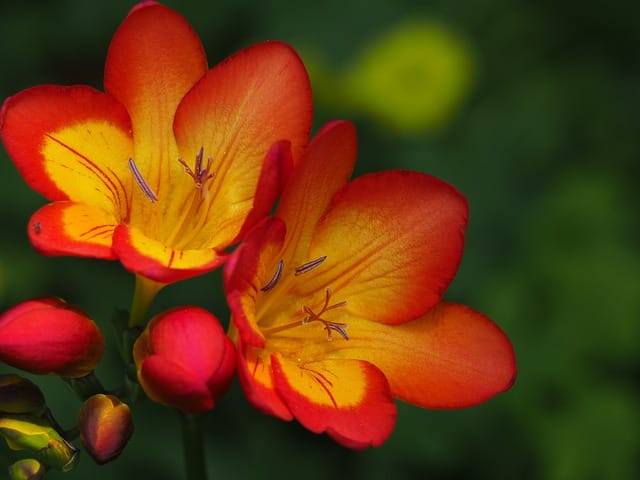How to grow Freesias
Freesias are beautiful and fragrant perennial flowers that are popular in gardens and floral arrangements

In this article:
- Introduction to Freesias
- Choosing a Location for Freesias
- Soil Preparation for Freesias
- Selecting and Planting Freesia Bulbs
- Watering and Fertilizing Freesias
- Providing Support for Freesias
- Managing Pests and Diseases in Freesias
- Freesia Care and Maintenance
- Propagating Freesias from Bulbs
- Extending the Blooming Season of Freesias
- Harvesting and Using Freesias
- Tips for Overwintering Freesias
- Troubleshooting Common Issues with Freesias
- Frequently Asked Questions about Growing Freesias
Introduction to Freesias
Freesias are beautiful and fragrant perennial flowers that are popular in gardens and floral arrangements. They are native to southern Africa and belong to the Iris family. Freesias come in a variety of colors, including white, yellow, orange, pink, and purple. These delicate flowers are known for their unique trumpet-shaped blooms and sweet fragrance.
Choosing a Location for Freesias
Freesias thrive in full sun to partial shade, so it is important to choose a location that provides at least six hours of direct sunlight per day. They also prefer well-draining soil and protection from strong winds. Consider planting freesias near a fence, wall, or other structures that can offer some degree of wind protection.
Soil Preparation for Freesias
Before planting freesias, it is essential to prepare the soil properly. Freesias prefer slightly acidic to neutral soil with good drainage. Amend the soil with organic matter, such as compost or well-rotted manure, to improve its fertility and drainage. Avoid heavy clay soils, as they tend to retain water and can cause the bulbs to rot.
Selecting and Planting Freesia Bulbs
Choose high-quality freesia bulbs from a reputable source. Look for firm and plump bulbs with no signs of rot or damage. Plant the bulbs in the prepared soil in autumn or early spring, with their pointed end facing upwards. Space the bulbs about 4-6 inches apart and plant them at a depth of 2-3 inches.
Watering and Fertilizing Freesias
Keep the soil consistently moist but not waterlogged. Freesias require regular watering, especially during their active growth period. However, they are sensitive to excessive moisture, so ensure that the soil has good drainage. Fertilize freesias with a balanced fertilizer every four to six weeks during the growing season to encourage healthy growth and abundant blooms.
Providing Support for Freesias
As freesias grow, they may require support to prevent them from bending or breaking under the weight of their blooms. Inserting stakes or using a plant support, such as a trellis or hoop, can help keep the plants upright and ensure their proper development.
Managing Pests and Diseases in Freesias
Freesias can be susceptible to pests such as aphids, slugs, and snails. Regularly inspect the plants for any signs of infestation and take appropriate measures to control these pests. Common diseases that affect freesias include fungal infections like botrytis and root rot. Ensure good air circulation around the plants and avoid overwatering to minimize these problems.
Freesia Care and Maintenance
Regular care and maintenance are crucial for healthy freesia plants. Deadhead faded flowers to encourage new blooms and prevent the plant from diverting energy to seed production. Remove any weeds that may compete for nutrients and water. Mulching around the plants can help conserve moisture and suppress weed growth.
Propagating Freesias from Bulbs
Freesias can be propagated by dividing the bulbs once they have finished flowering. Carefully dig up the bulbs, separate the offsets, and replant them in a prepared bed. Allow the newly planted bulbs to establish before expecting blooms.
Extending the Blooming Season of Freesias
To extend the blooming season of freesias, you can stagger the planting of bulbs or companion plant with other spring blooming bulbs like tulips or daffodils. This way, you can enjoy continuous floral displays throughout the spring season.
Harvesting and Using Freesias
Freesias make excellent cut flowers and are often used in floral arrangements. Harvest the blooms when the first few flowers on the stem have opened. Cut the stems at an angle and immediately place them in a vase filled with fresh water. Replenish the water regularly to prolong the vase life of the flowers.
Tips for Overwintering Freesias
In areas with cold winters, freesias may not survive outdoors. To overwinter them, carefully dig up the bulbs after the foliage has died back naturally. Clean the bulbs and store them in a cool, dry location in peat moss or sawdust. Replant the bulbs in the garden in early spring when the danger of frost has passed.
Troubleshooting Common Issues with Freesias
Freesias may encounter various issues, such as poor flowering, yellowing leaves, or stunted growth. These issues can be caused by factors like improper watering, nutrient deficiencies, or pests. Troubleshoot these problems by assessing the growing conditions, adjusting watering practices, and addressing any nutrient imbalances.
Frequently Asked Questions about Growing Freesias
Q: How long do freesias bloom?
A: Freesias typically bloom for about one to two weeks.
Q: Do freesias need to be divided?
A: Freesias should be divided every 3-4 years to maintain their vigor and prevent overcrowding.
Q: Can freesias be grown in containers?
A: Yes, freesias can be grown in containers as long as they have adequate drainage and receive sufficient sunlight.
By following these guidelines, you can successfully grow and enjoy the beauty and fragrance of freesias in your garden or indoor space.
